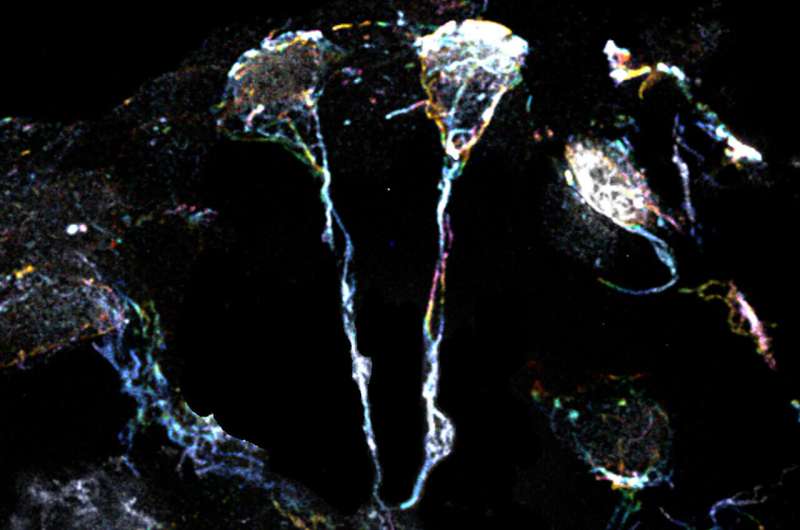This article has been reviewed according to Science X's editorial process and policies. Editors have highlighted the following attributes while ensuring the content's credibility:
fact-checked
peer-reviewed publication
trusted source
proofread
Scientists discover method to activate dormant stem cells in the brain

Scientists from Duke-NUS Medical School and the Mechanobiology Institute (MBI) at the National University of Singapore (NUS) have discovered a novel pathway to wake up dormant neural stem cells, offering potential new therapies for neurodevelopmental disorders such as autism, learning disabilities, and cerebral palsy.
In the mammalian adult brain, most neural stem cells, which originate from the nervous system and can grow into various types of brain cells, stay dormant until they receive specific signals that activate them. Once woken up, they produce new neurons, aiding in brain repair and growth.
Defects in neural stem cell activation are associated with aging-related cognitive decline and neurodevelopmental disorders such as microcephaly, a condition where a baby's head is much smaller than expected because its brain has not developed properly.
Neurodevelopmental disorders affect around five percent of children and adolescents worldwide and lead to impaired cognition, communication, adaptive behavior and psychomotor skills.
To study this activation, the scientists turned to Drosophila or fruit flies. Similar to mammals, the neural stem cells of fruit flies stay dormant till they are awakened. Their findings, published in Science Advances, showed that a type of glial cell named astrocytes—traditionally thought to provide structural and nutritional support—are important for waking up dormant neural stem cells in the brains of fruit flies.
Using super-resolution microscopy with 10-times magnifying power, the team of scientists examined the tiny fiber structures that are a hallmark of dormant neural stem cells of fruit flies.
These fine structures, around 1.5 µm in diameter (or 20 times smaller than the diameter of a human hair), are protrusions extending from the cell body, and are rich in actin or protein filaments. A specific type of Formin protein can activate these filaments and cause them to assemble.
Dr. Lin Kun Yang, who was a research fellow at Duke-NUS at the time of the study and the first author, said, "We decided to home in on this pathway as variants in Formin levels are associated with neurodevelopmental disorders like microcephaly in humans. Understanding this pathway could provide new insights into developing solutions to treat neurodevelopmental disorders."
The scientists observed that astrocytes release a type of signaling protein called Folded gastrulation or Fog, which sparks a chain reaction that includes activating the Formin protein pathway to control the movement of actin filaments. Ultimately, these processes rouse neural stem cells from their dormant state. They then start to divide, creating new neurons that contribute to brain repair and development.
The receptor protein named GPCR in neural stem cells then responds to Fog secreted from astrocytes, activating the signaling pathway that controls the formation of actin filaments in neural stem cells. GPCRs have major roles in fundamental cell processes.
As a result, the GPCR protein family has become a major drug target for treatments of various human diseases: 34 percent of FDA-approved drugs target this family of proteins. Therefore, understanding how this signaling pathway controls neural stem cell reactivation may provide a potential strategy for using existing drugs to treat neurodevelopmental disorders.
Professor Wang Hongyan, Acting Program Director of Duke-NUS' Neuroscience & Behavioral Disorders Research Program; and the senior author of the study, said, "Our findings add new knowledge to the limited body of research on mechanisms governing the reactivation of dormant neural stem cells. With our discovery of astrocytes as a key player in the reactivation of neural stem cells, we now have a new way to influence neural stem cell behavior."
Professor Patrick Tan, Senior Vice-Dean for Research at Duke-NUS, said, "This not only advances our fundamental understanding of how astrocytes influence brain cell development but also opens new avenues for advancing therapies for neurological disorders, brain aging and injury."
The scientists are currently investigating other signals from astrocytes that might influence the activity of neural stem cells. They also plan to explore whether similar mechanisms are involved in the development of the human brain.
This study is part of Duke-NUS' ongoing efforts to deepen understanding of the fundamental mechanisms at play in the human brain to create new therapeutic approaches, especially for patients with neurological conditions.
More information: Kun-Yang Lin et al, Astrocytes control quiescent NSC reactivation via GPCR signaling–mediated F-actin remodeling, Science Advances (2024). DOI: 10.1126/sciadv.adl4694



















